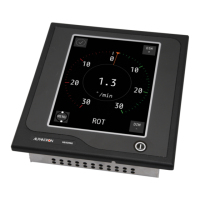4.1 Hardware Specifications
4.1.1 Specifications MFM
Box Contents upon Delivery
Rate of Turn Indicator MFM 3108.0096 grey / 3108.0098 black
Mounting bracket
Screws (4 pcs)
USB flash drive with manuals
Template for cut-outs
Physical Dimensions
Dimensions (WxHxD) 160x180x80 mm (6.30x7.09x3.15")
Panel cut-out (WxH) 138x172 mm (4.84x6.77")
Weight 1.23 kg (2.71 lbs)
Power Specifications
Power supply 24 VDC input +/- 20% (Single source)
Power consumption 12 W (24 VDC @ 500 mA in rush prox. 4 A)
Protection Reverse polarity protection
Start-up time 30 sec.
Operating Conditions
Operating temperature
-25°C to +55°C
1
Operating humidity Up to 95% (at 40°C)
Storage temperature -25°C to +70°C
Storage humidity Up to 95% (at 40°C)
IP rating IP56 front / IP22 back
Compass safe distance Std: 0.1m / Steering: 0.1m
Environmental according to DNV 2.4 table 2.1
Temperature Class D
Humidity Class B
Vibration Class A
EMC compatibility Class B
Enclosure Class C
Display Functionality
Font display text 7 mm (viewing distance = 2 m)
Font operation buttons 3.5 mm (viewing distance = 1 m)
Accuracy Resolution 0.1°/min
Acoustic noise level 0 db
Display Specifications
High quality TFT Touch screen 6.5"
Pixels 480 x 640 (aspect ratio 3:4)
Orientation Vertical
Light intensity Max. brightness 450 cd/m2
View angle (H/V) 140°/160°
Maximum colors 16.7 million
Input/Output Signals
COM 0 (IEC 61162-2) isolated Modbus RTU Rx/Tx
COM 1 (IEC 61162-1) isolated NMEA Rx/Tx
COM 2 (IEC 61162-1) isolated NMEA Rx/Tx
COM 3 (IEC 61162-1) isolated NMEA Rx/Tx
USB port (Mini) Used for software update/maintenance
Alarm output NOC contact (potential free)
Norms/Standards
IEC 60945 (2002) Incl. IEC 60945 Corrigendum 1 (2008)
Standard DNV 2.4 Det Norske Veritas
IEC 61162 series NMEA Definitions
IEC 62288 (2014) Testing methods
ISO 20672 (2007)
4.1.2 Available Accessories
Available Accessories
MFM IP56 Kit 3698.0018
Table 13: Available Accessories
1
Although the test conditions for bridge units provide for a maximum operation temperature of 55°C, continuous operation of all electronic components should, if
possible, take place at ambient temperature of 25°C. This is necessary for a long life and low service costs.
48 | Appendix A

